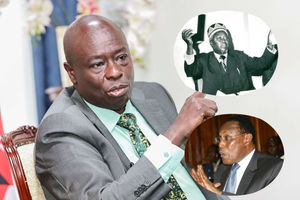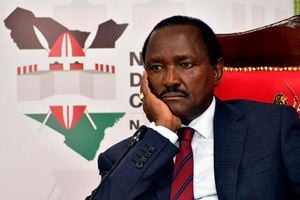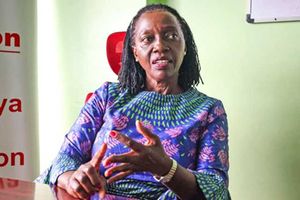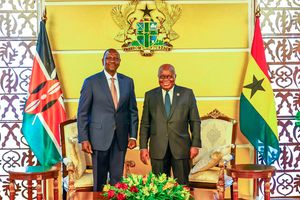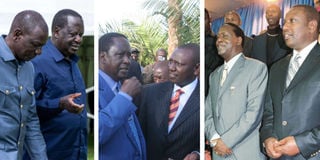
The recent political rapprochement between President William Ruto and opposition leader Raila Odinga has added yet another chapter to a colourful relationship between the two political giants that spans 30 years, starting from the Daniel arap Moi era.
After their last bitter contest — the August 2022 elections and the post-election protests that spilled into early 2023 — the surprise announcement that Mr Odinga would be going for the African Union Commission chairmanship with the backing of President Ruto’s administration continues to stir the political landscape.
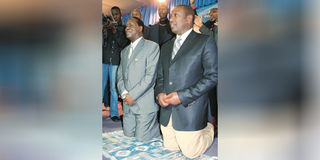
ODM leader Raila Odinga (right) and Pentagon member William Ruto kneel at the altar before being prayed over by Bishop Margaret Wanjiru during a prayer service at Jesus Is Alive Ministries in January 2008.
Here is a look at key moments and events that have defined the relationship between Dr Ruto and Mr Odinga.
1992: William Ruto joins Youth for Kanu 92 (YK’92), Raila Odinga is elected MP
Ruto starts his political career as an official of the controversial YK’92 lobby group supporting the election of President Daniel Moi as Kenya returns to multiparty politics while Raila is elected Lang’ata Constituency MP as a member of the Opposition party Ford Kenya. There is no indication of any direct interaction but the two were active participants on opposite sides during a heated political period.
1997: Ruto elected Eldoret North MP under Kanu party, Raila loses presidential election
Eldoret North Constituency gives Ruto his first taste of elective politics victory as a Kanu MP while Raila is re-elected in Lang’ata Constituency but loses for the first time as a presidential candidate on a National Development Party(NDP) ticket.
Three years later, Raila’s NDP announces “cooperation”with President Moi’s Kanu, where Ruto is a key player In 2001, Raila is appointed Energy minister while Ruto is an assistant minister in the office of the President
2002: On the same side: Deal between Kanu and Raila’s NDP
6,000 branch delegates (4,500 from Kanu and 1,500 from NDP) meet at the Kasarani Sports Centre Gymnasium to witness the merger between President Moi’s Kanu and Raila’s NDP. The opposition politician is named New Kanu Secretary-General.
Ruto and Raila are on the same side of the political divide for the first time after a short-lived deal between Kanu, where the Eldoret North MP is an official, and NDP. Raila and his allies eventually leave Kanu—disintegrating the ruling party by leaving with key members after Uhuru Kenyatta is named the presidential candidate. Ruto remains in Kanu and is appointed Minister of Home Affairs.
2002: Ruto’s Kanu candidate loses to the opposition Narc, where Raila’s party is a key member
The 2002 election in Kenya is highly anticipated because it is not only the first transition in 24 years with Daniel arap Moi retiring but also the first time Kenya is going to have a new president while the retired one is still alive.
Ruto is a key supporter of Kanu’s losing Presidential candidate Uhuru Kenyatta while Raila’s NDP joins the National Rainbow Coalition (Narc), whose candidate Mwai Kibaki wins the election.
2003: One is a minister, the other an opposition MP
President Kibaki appoints Raila Odinga Minister of Roads and Public Works with Ruto on the opposition benches as Eldoret North MP.
2005: Referendum: Raila and Ruto join hands to oppose the new constitution
Ruto becomes the Secretary-General of Kanu. The same year, the government proposes a new Constitution, which Ruto and members of Raila’s LDP oppose. At this point, Raila and Ruto share the same political stance and join forces with others to campaign against the new Constitution on the triumphant Orange side (No), dealing President Kibaki’s Banana side (Yes) a big blow in the referendum. Raila and his allies are ejected from the Cabinet.
Ruto would later leave Kanu to join hands with Raila in ODM, a party created by key politicians in the Orange side during the referendum.
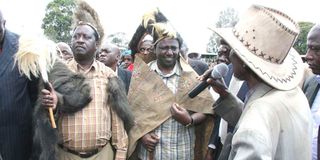
Then Prime Minister Raila Odinga (left) and then Agriculture Minister William Ruto being conferred Tugen Elders by Mzee Rotich Chebyegon at the Kabarnet Agricultural Showground in September 2008.
2007/2008: Raila loses to Kibaki in a disputed vote that triggered violence. Raila is named Ruto and Raila are key players in Grand Coalition government
In the hotly contested December 2007 presidential election, Ruto, as part of ODM, supports Raila in his bid to unseat the incumbent President Kibaki. The presidential election is highly disputed, leading to the post-election violence. This crisis is resolved through the internationally-mediated National Accord and Reconciliation Act of 2008.
As part of the power-sharing agreement, Raila is named the Prime Minister, a position he held from 2008 to 2013, while William Ruto is appointed Agriculture minister (2008–2010) and Higher Education minister (2010–2011). Many of Ruto’s supporters had hoped he would be appointed one of the Deputy Prime Ministers instead of Musalia Mudavadi.
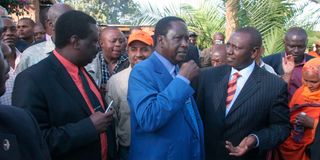
Then Prime Minister Raila Odinga (centre) with Musalia Mudavadi and William Ruto (right) after the ODM Party elections at the Bomas of Kenya in Nairobi in December 2008. Mr Odinga was elected Party Leader.
2010: Raila ‘fires’ Ruto; Kibaki rescinds decision
In 2010, Prime Minister Raila Odinga announces the suspension of Ruto as Agriculture Minister over corruption allegations. However, President Kibaki overturns this decision, escalating the tensions between Ruto and Raila.
This event, where the fallout played out in the open, is a significant turning point in their relationship
2010: Don’t be vague, go to The Hague: International Criminal Court (ICC) politics
Ruto and Uhuru Kenyatta are among six prominent Kenyans named by The Hague-based court for their alleged role in the 2007/2008 post-election violence. In what would later become a key 2013 campaign issue, they blame Raila for ‘fixing’ them and making sure they are charged at the ICC. All the cases are dropped over the years after initial appearances at The Hague.
2010: Referendum: Ruto in ‘No’ camp, Raila in ‘Yes’ camp
In 2010, Kenya goes through a major constitutional review process. This leads to a referendum where people voted on whether to accept the new constitution. Ruto, who is the Minister for Higher Education, is a leading figure in the group that opposed the new constitution, called the ‘No’ camp. They lost. Raila is a key figure in the winning group that supports the new Constitution.
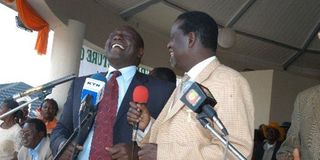
ODM presidential aspirants Raila Odinga (right) and William Ruto in a jovial mood during the Rift Valley Province leaders' meeting at Poa Place in Eldoret in August 2008.
2013/2014: Ruto teams up with Uhuru; Raila forms Cord
Ruto teams up with Uhuru Kenyatta as running mate for the 2013 presidential election. Raila forms the Coalition for Reforms and Democracy (Cord) in December 2012, which also includes Kalonzo Musyoka as running mate, and Moses Wetang’ula. Uhuru and Ruto win the election by a narrow margin.
2017: Uhuru and Ruto win re-election bid, Raila challenges election results in court
In the 2017 General Election, Uhuru and Ruto are re-elected on a Jubilee Party ticket. However, the election is marked by controversy and disputes.
Raila and his Nasa coalition contest the results in the Supreme Court, alleging irregularities. The court subsequently nullifies the presidential election results, a first in Kenya.
A fresh election is conducted in October but Raila boycotts it. Despite the low turnout, Uhuru and Ruto are declared winners once again as the opposition continues with weeks of protests.
2019: The divide over the Building Bridges Initiative (BBI)
Raila and Uhuru are key supporters of the BBI constitutional amendments and reforms efforts which start afterthe handshake.
Ruto and his supporters oppose BBI. They believe a referendum, which would have to be done if the BBI is passed, is unnecessary and costly. It would also likely boost Raila’s political stock ahead of the next elections.
The Uhuru-Raila reforms efforts are eventually thrown out by the courts, giving Ruto the momentum to campaign.
2022: Ruto wins August elections; Raila leads post-election protests
In the August 2022 presidential election, Ruto, running on a Kenya Kwanza Alliance ticket, is declared the winner in a close race against Raila on an Azimio la Umoja One Kenya coalition ticket.
Raila unsuccessfully challenges the results in the Supreme Court.
2023: Protests and truce
Raila intensifies post-election protests early in the year, with the additional demand that the Ruto administration should lower the cost of living.
The protests are halted after a Ruto-Raila truce leads to a joint dialogue committee formed to address concerns raised. The National Dialogue Committee report is currently before Parliament.
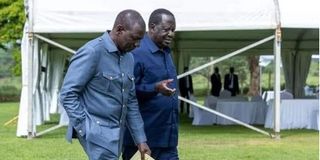
President William Ruto (left) and opposition leader Raila Odinga in Kisozi, Uganda, on February 26, 2024.
2024: Raila announces bid for AU Commission chairmanship; Ruto backs him
After Raila officially announces his candidacy for the Chairperson position of the African Union Commission, President Ruto expresses his support for the bid.
Ruto, Raila and Uganda’s President Yoweri Museveni meet in talks said to have guaranteed Kampala’s support for Raila’s AU campaign.
Ruto begins shuttle diplomacy across the continent to campaign for Raila.



